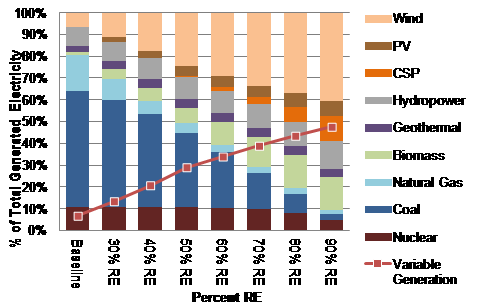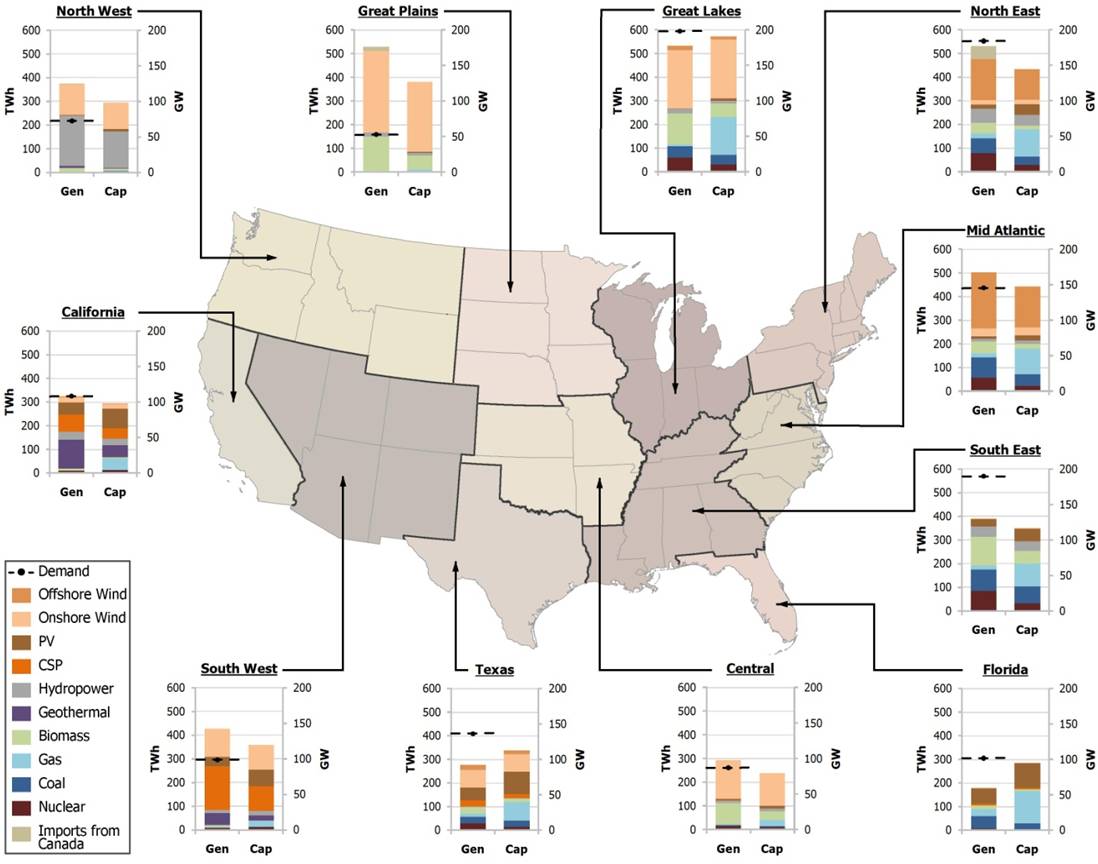In June, the National Renewable Energy Laboratory (NREL) released a groundbreaking new study showing that the United States could generate 80 percent of its electricity from renewable energy by 2050 with commercially available technologies, while meeting electricity demand in every hour of the year and every region of the country.
The study also found that a high renewable electricity future would result in deep reductions in power plant carbon emissions and water use at costs comparable to other studies.
As one of 140 peer reviewers of this massive four-volume, 850-page Renewable Electricity Futures Study, it is arguably the most comprehensive analysis of a high renewable electricity future in the U.S. to date. It provides unprecedented geographic and time resolution for long-term studies of the U.S. power sector. It also includes a detailed assessment of the costs, challenges, and opportunities for each renewable energy technology and uses state-of-the-art modeling to show how they can be effectively integrated into the electricity system. More than 110 experts representing 35 diverse organizations contributed to this landmark study.
Here are some of the key findings:
No major technological breakthroughs are needed
The study shows that an 80 percent renewable electricity future can be achieved with diverse technologies that are commercially available today. These include wind turbines, solar photovoltaics (PV), concentrating solar power (CSP), biopower, geothermal, and hydropower. Wind and solar are the biggest winners, providing roughly half of total U.S. electricity generation by 2050. Biopower, geothermal, and hydro also make meaningful contributions for the remaining 30 percent. They did not include many emerging renewable energy technologies that have significant long-term potential, such as enhanced geothermal systems, wave and tidal power, floating platform offshore wind turbines, and solar nanotechnology.

Renewable energy can make a significant contribution in every region
While wind power expands in most regions, the highest levels are found in the Great Plains, Great Lakes, Central, Northeast, and Mid-Atlantic regions. Offshore wind represents a large share of wind development in the Northeast and Mid-Atlantic. Regions with the greatest deployment of solar power are the Southwest, California, Texas, Florida, and the Southeast. Biopower plays a smaller but important role in the Southeast, Great Plains, Great Lakes, and Central regions. Geothermal development is concentrated primarily in California and the Southwest. Hydropower continues to play a big role in the Northwest, but also makes an important contribution in California, the Northeast, and the Southeast.

Regional electricity generation and capacity in 2050 under 80% renewable electricity future
NREL has posted some very cool visualizations on their website that show how the U.S. electricity system could be transformed to a high renewable energy future between 2010 and 2050, and the hourly operation and transmission flow of that system in 2050.
Multiple technology pathways are available
The study shows an abundance and diversity of renewable energy geographically distributed across the United States, with a technical potential of over 128,000 gigawatts (GW) of capacity from commercially available technologies. That’s 128 times the current capacity of the U.S. electricity system! Because of this, NREL’s modeling of over two dozen scenarios considering a wide range of assumptions and conditions show that many different combinations of technologies could be deployed to achieve a high renewable energy penetration.
Grid operators can keep the lights on in every hour of the year in every region
The study also shows that with a more flexible electricity system, grid operators would be able to balance electricity supply and demand in every hour of the year with 80 percent renewable electricity. This includes scenarios with nearly 50 percent of total U.S. electricity coming from variable wind and solar PV generation.
Using their Regional Energy Deployment Systems (ReEDs) model, NREL projected changes in generation, transmission, and power flows for 134 power control areas in the U.S. through 2050. Then they analyzed the hourly impacts of these results by running them through a detailed production cost model of the U.S. electricity system frequently used by the utility industry. Despite this highly rigorous modeling, NREL humbly notes that they did not conduct a full blown reliability analysis, which would include “sub-hourly, stability, and AC (alternating current) power flow analysis.”

Installed capacity is sufficient to meet summer afternoon peak demand with 80% renewable electricity and a more flexible grid.
A more flexible electricity system is needed
Achieving 80 percent renewable electricity will require making several fundamental changes to the grid. These changes include building new high voltage transmission lines, designating larger areas for balancing supply and demand, and smoothing out renewable generation from multiple facilities, improving scheduling (every 10-15 minutes) and forecasting of variable renewable resources, investing in electricity storage technologies, paying customers for reducing electricity use during high demand periods (a.k.a. demand response), and implementing several institutional reforms. While these are big changes, the good news is that the Federal Energy Regulatory Commission (FERC), regional grid operators, and utilities are already pursuing many of them.

Power plant carbon and GHG reductions
A renewable electricity future will have big climate and water benefits
Achieving an 80 percent renewable electricity future would reduce coal and natural gas use by about 80 percent by 2050. This translates into an 80 percent reduction in power plant carbon emissions that are contributing to climate change and a 50 percent reduction in water use for power plant cooling by 2050. This is significant considering that the power sector is currently responsible for more than 40 percent of both energy-related carbon emissions and total freshwater withdrawals in the United States.
NREL’s cost estimates are conservative
NREL found that “the direct incremental cost associated with high renewable generation is comparable to published cost estimates of other clean energy scenarios” modeled by federal agencies between 2009 and 2011.
They also found that improvement in the cost and performance of renewable technologies is the most important driver for reducing costs. Even under scenarios that use different assumptions for electricity demand, technology costs, and natural gas and coal prices or impose transmission, grid flexibility, and renewable resource constraints, they show that the United States can still achieve 80 percent renewable electricity by 2050 with only small changes in costs.

However, there are several reasons to believe that the study’s cost estimates are conservative:
- For most scenarios, NREL assumes the United States will adopt policies to increase energy efficiency that will flatten out electricity demand over time, but they do not include any savings on consumer electricity bills from reducing electricity use. A 2009 UCS study of a high-efficiency and renewable energy scenario showed net annual savings of over $100 billion after paying for the costs of investing in efficiency and renewable energy.
- It does not include any savings from reducing natural gas use for generating electricity that could lower natural gas prices and bills for consumers and businesses that use natural gas for heating buildings, industrial processes, and other uses. Studies by EIA and UCS of renewable electricity penetrations of 25 percent by 2025 have shown that savings on consumer natural gas bills can offset most or all of the projected increase in electricity bills.
- It assumes new renewable energy facilities will primarily replace existing fossil and nuclear power plants that have already paid off some or all of their capital investment instead of replacing more expensive new plants.
- The study uses technology assumptions developed in 2009 and early 2010 that don’t fully capture recent cost reductions for solar PV and projected near-term cost reductions for wind.
- It does not include the environmental and public health benefits of reducing air and water pollution and solid wastes from mining, drilling, transporting, and burning fossil fuels or reducing disposal of radioactive wastes from nuclear power. And it doesn’t consider any avoided costs and impacts of climate change that would occur under their baseline scenario.
Policies are needed to achieve an 80 percent renewable electricity future
While the study does an excellent job describing the technical changes that would be needed to operate the U.S. electricity grid with 80 percent renewable electricity, it does not identify the policies that are needed to get there.
Perhaps the most important near-term opportunities are for Congress to extend renewable energy tax credits and for states to enact and strengthen policies such as renewable electricity standards. State and regional implementation of FERC Order 1000 and new power plant regulations to protect public health also provide near-term opportunities for renewables to replace retiring coal plants, build new transmission lines, and advance grid planning and integration approaches.
But to really achieve a high renewable future, drive down costs, create new jobs, and significantly reduce carbon emissions and water use, the United States needs a long-term national renewable energy policy. This should include a national renewable electricity standard or well-designed “clean” energy standard, a price on carbon emissions, and a significant increase in research and development funding.
